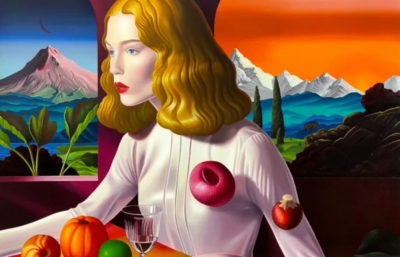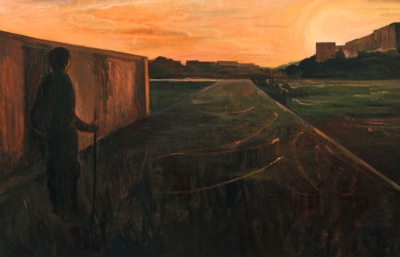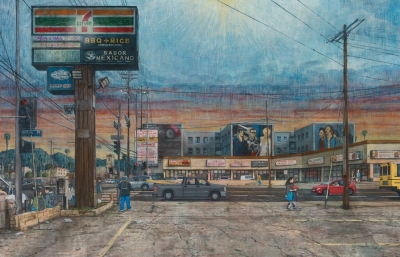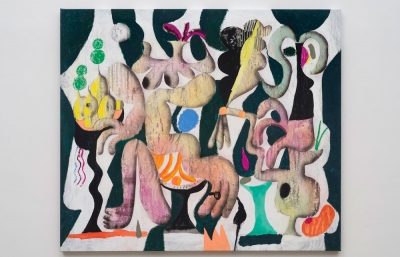Molly Bounds
The Power of Quiet
Interview by Gwynned Vitello // Portrait by Erin Bounds

When lunchtime buddies, in a barroom bet, challenged Ernest Hemingway to author a short story in six words, he famously grabbed a napkin and wrote, “For Sale Baby Shoes, Never Worn.” There he distilled the essence of a genre, telling a tale in an entrancing engagement of economy, form and creativity. That would describe the talent of Molly Bounds, who creates her own compelling short stories in the form of painting and printmaking. Colors don’t riot, they enfold, conveying a distinctly palpable mood or time of day. Beguilingly, there’s often a mystery, with nuance in the shape of an ear or strand of hair, but savor the time spent because somehow it ends up feeling familiar. Bounds recently relocated from Denver to Los Angeles, where she was able to sneak in a session of clown school before sheltering in place in her new home.
Gwynned Vitello: Of course, my first question has to be about your “clown intensive.” When I looked up famous female clowns, I was surprised to note that the only American listed was Lucille Ball! There were many others from around the world, Annie Fratellini from France and Pepe Plana from Spain, for example. How long have you been interested?

Do you like to be referred to as an illustrator, printmaker or artist, or I guess I mean, do you care?
By day I mostly paint, but I identify with the process and ethics of printmaking. I’m highly ADHD and get the urge to switch mediums after almost every piece I finish. I flail and squirm if I start to feel nailed down to one thing. When I make two paintings in a row that seem too alike, I restlessly fiddle with some new print process to jog my adrenaline.
Actually, this is a compliment, but here I am interviewing an artist, and the more I read about you, the more I get a sense that that art community is what guides you, almost as much as you individually making art.
I didn’t realize how real that was until I moved away from Denver. It didn’t hit me until I was somewhere else and felt like I had no compass for why I was making art anymore. Even though I feel a great sense of belonging here, I could relate in weird ways to being a kind of empty-nester when I moved to Los Angeles. Being part of a smaller scene made everything feel really important, and that everything we were doing mattered in a big way. The DIY community in Denver is really big-hearted and tries to carry the weight of the city’s issues on its shoulders. The impact of every DIY space, collective, event, project, gathering and fundraiser, was felt so heavily. The participants felt it their duty and necessity to support the scene, which made every closure that much more painful.
What is it you love most about making prints?
With printmaking, there are elements of relinquishing control that I find harder to access in my painting process. I’ve captured a rare happiness when I’ve let go enough to surprise myself. When printing, my entire body gets to channel its energy towards a purpose, each limb tending to its separate duty, swift, yet careful. Once in full swing, the muscle memory takes over. I know the dance and I don’t have to think about it, and it’s always the most blissful state of making for me.
Do you still work in a print shop? And if so, how did you spend your days, did you alternate your time between print shop and a studio? Were you doing two distinctively different types of work?
I haven’t worked in a print ship for years, but I would love to work in one again. There was this rowing press called the Cincinnati One-Arm Bandit that made it easy to make large prints with big gradients, and I always liked trying last-minute color and paper combinations toward the end of my run of prints. Before I worked in the shop, I was really into black-and-white graphic stuff. That died the day I started in the print shop when my first role was color mixing. I became quickly obsessed with color. There was a giant cabinet of leftover inks that were available to me if I wanted to print something, and that really helped shape my taste for muted palettes.

I like going into the office and spending time exchanging ideas with the crew. But I absolutely also need my time alone, and I think the two compliment each other. How about you?
I need to have a group of people who like to spitball ideas in the morning. Recently, for my birthday, my sister signed me up for a character development workshop. Our teacher, John Milhiser, would have us start class every day by describing who we saw that week, maybe an experience that really stuck out to you, and sometimes you’d have to workshop right there what that character looked like and emphasize what was strange about it. Having a daily exercise like that right before my day in the studio always led to a really productive day. I like bouncing ideas off of others, especially through the ideation process, and helping them along with theirs. Once I start the process of making something, though, that's when I have to be alone to get anything done.
I know you’ve loved comics your whole life. Starting with single panel cartoons? And/or did you start with picture books as a little kid?
My parents met working at a graphic design firm, doing logos and font design, and my mom actually did layout work for the Rocky Mountain Newspaper, so the funnies were something we all related to. What I thought, at the time, was standard kid stuff, I later understood as very special. I vividly remember these Seymour Chwast illustrations in this poetry book my mom read to me, and growing up on Edward Gorey’s Rumpelstilskin. My dad brought in comic influences like Matt Groening’s Life in Hell books, Gary Larson and Peanuts. When I see Milton Glaser stuff, it reminds me of my childhood because I think both my parents had a predilection for ’60’s and ’70’s design. The first art I remember looking at was the art my mom made, a very psychedelic drawing of a colorful cartoon car driving up a mound of colors that read, “Baby, Oh Baby.”
Would you say that now you prefer graphic novels for reading? You make zines, right? Have you ever tried a graphic novel?
I intended to come out of college making comics, but narrative in the form just didn’t come out naturally to me—too many decisions to make that felt so final! I’d spend so much time mulling over just one frame, and I still found myself torn between the still image and a sequence of motion. If anything, the frustration and fear of making those decisions drove me toward painting.

When did you start painting? Did you go to art school? And—here is where we get all sorts of answers—how was the experience?
I attended the art program at Metro State College of Denver with plans to go somewhere else at some point, but then immediately found my people. I loved being at school for too long, as well as being in the print studio. I would say I eagerly and enthusiastically approached critiques and art theory or any chance to have class discussions. I liked learning and being actively engaged by the learning process, but more passive modes of learning did not stick with me very well, and time management was a battle I lost every day, no matter how hard I tried. Unfortunately, good grades often hinged on timeliness, but there were teachers I’m so grateful for who were a little casual and abstract themselves, and treated students like we were equals—usually the same ones who showed up to our art shows, even outside of school. They have remained as mentors and friends. Their classes and the collective energy of the students in those classes was so infectious that I loved school, even when it hated me.
I’m excited to get to talk about your paintings because I love the mood they create. There’s something about the palette and the subjects’ postures that allow a viewer to enter and suppose their own story. Also, you’re not necessarily imposing a scenario on us.
It’s more about the emphasis of one feeling, slowed down and reiterated like it’s repeating, glitching, even, and being re-lived. I’m specifically drawn to tension created by a tone that’s hard to read, or when you can’t tell if you’re seeing something from a flawed point of view.
How did you develop the colors you use? Especially in a time when there is such a taste for bright, lacquered pieces.
I appreciate when something quiet is given a lot of power. I usually try to posit a color to become the most important or significant element in a picture. There are a handful of artists, dancers, comedians, comics and friends that helped me understand this nature that excites me most, the potency of something that is also subtle.

Do you use live models? Their beauty lies in how relatable they are, but the treatment is respectful, which makes me feel that the models are friends of yours. And do the models pose, or do you paint from photos?
Unusually, it’s a posture and expression I’m mentally stuck on, so I’ll take a lot of dopey references of myself to narrow down the pose, and then, if I can wrangle ’em, I have my friends do the same poses. Taking those pictures is sometimes my favorite part, because with references of myself, it’s something that starts off as a joke, like a sloppy caricature. Once there’s a real person across from me assuming the role or the feeling I’ve described, suddenly it all turns serious. Sarcastic exaggeration goes awry, and then I tell myself that was the point all along!
Has anyone asked about the mouths you draw? I wouldn’t call them grim, but there seems to be a resignation, or maybe just acceptance. I mean, I don’t see any big grinning—or petulant pouting. Somehow, they seem important.
I paint people who are preoccupied, because there is no way of telling what they’re thinking. I had the 1000-yard stare since I was a kid, and not because I had a trauma or anything. I just chose to inhabit a different reality a lot of the time. An interesting part of falling out of focus is how peaceful it can be. It seems as though the only difference between dissociation and meditation is the level of presence. I’m drawn to that thin coat of ambivalence or content in someone's face, where it’s hard to tell if they’re present or absent in themselves.
Is that you on horseback next to your painting In No Time?
That’s actually a picture of my Aunt Cindy from when she was about 14. Luckily, my Mom and grandpa were photographers and were really good about documenting everything. Sometimes, when I get stuck with imagery, I dig through the archive, because I’m pretty motivated by the spirit of the women in my family, the way we all wear our emotions right on our faces, sharing a familiar scowl. Sometimes, just the way their hand is rested on their hip told me everything I needed to know. It was maybe a few years ago, I was looking through an album and could have sworn it was me in the picture, enough like me to make me really look. But it was Aunt Cindy riding a horse barefoot. I wish the picture was me, but it made it much easier to envision an alternate life.

I’ve noticed that you give a lot of attention to strands of hair, how it falls, how it’s arranged.
Hair was the first thing I remember really wanting to know how to draw well. It was maybe second grade when I made this book of “build your own dream self”—not very self-loving, but I would argue progressive for early analog avatars! Every page was a variety of different noses, eyes, lips, and hairstyles to construct the perfectly Frankensteined image of beauty. No hands, because I hadn’t figured them out yet, and hey, who needs ’em? Every girl I would draw had a shy demeanor because her hands were hidden behind her back; and if she had an umbrella or accessory, it conveniently levitated nearby. I did not really draw boys or men; I was just not interested. Hair is something I always save for painting, like it’s dessert. I hyper-focus on loose strands, and flyaways in a funny effort to perfect imperfection. It’s an easy way for me to create movement or embody kinetic energy in a still image, which is usually my intention. This is the language I appreciated most from comics, the way a single frame can convey a series of actions, showing the past, present and future in one chosen moment. Nothing does it quite like comics.
I’m still laughing about your “dream self,” but I was going to ask about what seems to be your predilection for painting women. I’d say I prefer to read about women, for example. I guess I approach reading emotionally, so I relate better.
I often paint people who are androgynous, so I was only made aware it was a preference because of how often I get asked why I paint them! It wasn’t really an active decision to only paint women, but I was painting an experience I related to, and it’s no coincidence that women, especially, have more often shared those experiences. I’d like to paint more men, but that probably has to do with how very intimate it feels to take someone’s picture, and naturally, I feel more comfortable with someone who’s just as comfortable with me. Sometimes I’ll take someone’s picture whom I don’t know well as an excuse to get to know them better or to see them in a different light. I remember I was out shooting some pictures of my friend Curtis Park in Denver, and this man walking by started asking questions about what I was doing, and, then and there, he just asked if he could be a model—and he started doing just that! The spectrum of vulnerability and openness he shared with me about himself in a matter of five minutes broadened my vision of what confidence could look like. He’s probably the first male I’ll paint that I don’t already know well, and the first person I’ll paint who is smiling in their picture!





